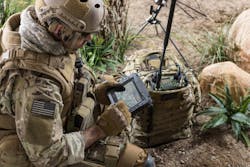Wanted: RF-and microwave components to enable software-defined radios to operate in contested environments
ARLINGTON, Va. – U.S. military researchers are asking the RF and microwave industry to develop wideband adaptive RF filters and cancellers to enable the use of wideband software-defined radios in congested and contested environments.
When exposed to interference and self-interference, these filters and cancellers will sense and adapt automatically to the electromagnetic environment through the intelligent control of their adaptive hardware. The idea is to attenuate interference -- particularly in contested environments -- selectively and protect wideband digital radios from saturation.
Officials of the U.S. Defense Advanced Research Projects Agency (DARPA) in Arlington, Va., have issued a broad agency announcement (HR001120S0027) for the Wideband Adaptive RF Protection (WARP) project.
DARPA wants industry to develop wideband adaptive filtering and self-interference cancellation circuits to enable the use of wideband software-defined radios in spectrum-congested environments.
When exposed to external interference or self-interference, WARP signal filters and cancellers will sense and adapt to the electromagnetic environment through the intelligent control of adaptive hardware.
Digital receivers historically have been narrowband because they are limited by A/D converter bandwidth, DARPA researchers explain. For these narrowband systems, pre-planned filtering prevents unwanted signals from reaching the A/D converter.
In the last decade, however, A/D converter technology has achieved greater than 10 GHz of instantaneous bandwidth with 8-10 effective number of bits (ENOB).
This performance is sufficient for wideband digital receivers but poses two challenges: wideband A/D converters typically have a relatively small available input voltage swing and reduced dynamic range when compared to their narrowband counterparts; and as the bandwidth increases, more signals come into view, which mean larger voltage swings into the A/D converter.
The DARPA WARP program seeks to protect these wideband receivers against external and self-interference through adaptive equalization of the input spectrum to stay within the dynamic range of a wideband digital receiver.
Today, receivers are protected from external interference through static filtering, automatic gain control, or signal limiters. Yet static filtering only uses a fraction of the digital receiver bandwidth, which gives good sensitivity but does not take advantage of available receiver bandwidth. Automatic gain control, meanwhile, capitalizes on system bandwidth, but decreases sensitivity to small signals.
At the same time, signal limiters can cause cross-modulation distortion and may decrease the overall sensitivity of the system. Tunable filters sometimes are a solution, but rarely can tune over achievable bandwidth.
Instead, the WARP program seeks is to develop wideband, adaptive filters and analog signal cancellers that selectively attenuate or cancel external and self-interference to protect wideband digital radios from saturation, ultimately enabling the use of software-defined radios in congested and dynamic spectral environments.
The ideal wideband receiver would adapt to jammers or blockers to maintain dynamic range without decreasing sensitivity and bandwidth. the WARP project seeks to develop adaptive filters to reconfigure their frequency response automatically to include pass/stop bands with bandwidth and center frequency tuning and attenuate large signals selectively while passing small or desired signals.
The challenge is to do this over a wide bandwidth with low-insertion loss at the input of a receiver. Today, most chip-scale tunable filters are limited to a 2:1 tuning ratio or less without explicit band switching.
The WARP program, instead, seeks demonstrate adaptive RF filtering of external interference with a 9:1 tuning ratio to provide full-band coverage across 218 GHz with new filter architectures based on state-of-the-art components and packaging.
The WARP program consists of two four-year technical areas: wideband adaptive filtering; and wideband signal cancellation. Several contractors will be involved.
Companies interested should submit full proposals to the DARPA BAA Website no later than 4 June 2020 online at https://baa.darpa.mil.
Email questions or concerns to DARPA's Timothy Hancock at [email protected]. More information is online at https://beta.sam.gov/opp/0e4de09e45a44562b72ee9646a0a57de/view.

John Keller | Editor-in-Chief
John Keller is the Editor-in-Chief, Military & Aerospace Electronics Magazine--provides extensive coverage and analysis of enabling electronics and optoelectronic technologies in military, space and commercial aviation applications. John has been a member of the Military & Aerospace Electronics staff since 1989 and chief editor since 1995.

